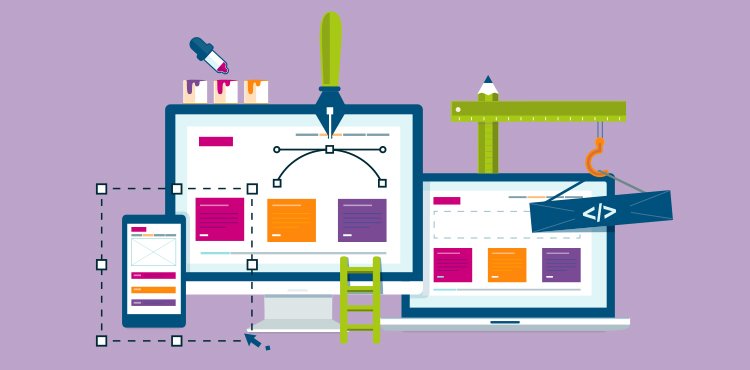
When it’s time to overhaul your firm’s website, it can be difficult to know where to start. Should you begin by finding a design that everyone loves, and then fill in the content? Or should the content come first, and drive the design? There are definitely pros and cons to both methods.
Starting with a Template
The vast majority of websites today are built using a pre-existing “template” or “theme” (as WordPress calls them). WordPress is the world’s most popular content management system (CMS) and a large part of its popularity is due to the countless attractive themes readily available for free, or for a minimal cost. There are also many website platforms that let you pick a template and host your site, turnkey, for free or for a low monthly price. Starting with an existing template design can really streamline the entire website process, but there are disadvantages as well.
Advantages:
- Once a template is selected, design decisions are pretty much set in stone (so there are no rounds of back-and-forth.)
- Templates come fully programmed so you don’t need a programmer to code the site, it’s already built. However, you’ll usually still need someone with programming experience to set up a temporary environment while you build the site (until you are ready to push it live, replacing your live site.)
- For new companies just starting out, using a platform like Squarespace or Wix can make the process of getting up-and-running much easier. Especially if you need to include e-commerce on your website.
- Using an existing theme can save substantially on the overall website cost. For small businesses or firms with a tight budget, a theme may be the only option.
Disadvantages:
- Finding the “right” template can be tricky. There are so many to choose from, it can take days or weeks to actually select one (especially if it is a group decision.)
- Most themes will lack some of the features you may really need/want for your site, so compromises will have to be made. If necessary features are missing from the template and have to be added in, finding a programmer to do that can be difficult and costly. And if you are on a platform like Wix, impossible.
- It’s easy to find templates for industries like salons, restaurants, and photo studios, but engineering firm templates are not as abundant.
- Templates often lack functionality that is important for A/E/C websites, like the ability to sort project portfolios, cross-link content (to relate people with projects or news stories, for example), robust search returns, etc.
- Once you do find a theme you like, the demo may look fantastic, but that doesn’t guarantee the actual theme will work as well. Many templates, even WordPress themes, are poorly coded, making your site very difficult to manage and often slow to load. There’s nothing worse than investing countless hours building a new site on a poorly coded theme, only to find you need to scrap the entire site and start over soon after launch.
- If you build a site using a service like Wix or Squarespace, you can’t move the site off their platform. You must rely on them to help fix any issues that may arise.
Starting from Scratch
Truly custom-designed sites allow for full flexibility. If you can envision it, chances are it can be built (with the exception of scratch-and-sniff sites, but I’m sure that’s coming soon.) I always advocate for custom-designed websites, but they have their pros and cons as well:
Pros:
- When you begin with a clean slate, you can address your website’s goals as step one. What does each of the project’s stakeholders want the new site to accomplish? You may be most interested in adding responsive capabilities for mobile viewing, the HR Director might be focused on adding video to boost recruiting, and the VP of Sales might want marketing automation integration to help with lead generation. Unless you define the goals up front, it’s impossible to build a successful site.
- Custom sites allow the design to really coordinate with and (in many ways) drive your firm’s brand. For professional service firms, our website is the “hub” of our marketing. We drive traffic to our site from our social sites, our printed materials, ads, press releases, and other outlets. It’s crucial that our website accurately convey our brand both visually and with the words we choose throughout its pages.
- Rather than starting with a template and “filling it in,” custom design lets you start with the content and design to meet your goals. For example, instead of asking: “What photos should go in the big homepage slider?” you can ask: “Do we want a big homepage slider, or should we have one large video, or two equally sized areas to emphasize the two industries we’re targeting?” Instead of saying: “We need 5 photos for each project carousel,” you can ask: “Do we really need a separate project section? How do our visitors explore our content and find the projects they are most interested in?”
Cons:
- Custom sites, almost always, take more time. More thought and research tends to go into the preparatory stages. Brand analysis is often an initial step.
- Custom sites are more expensive. Not only does the design of the site cost more, the programming can cost close to or as much as the design.
- Similar to templated sites, just because the web agency’s portfolio looks great, there’s no guarantee the site they deliver will be well coded and easy to manage. Make sure you see examples of their CMS and “back end” administration before you sign on the dotted line.
- Many agencies that build custom sites will mandate your site be built using their proprietary CMS. That means you get locked into their ongoing hosting and maintenance fees, and you can’t (usually) take your site and move it elsewhere. In truth, custom sites do not necessitate custom, proprietary CMSs. We often use WordPress to build custom sites, essentially creating a completely unique “theme” based on our client’s goals. A WordPress site can be hosted almost anywhere, and you can keep your existing URL.
Often, an effective first question to answer when starting a website project is “How much is in our budget?” An established budget can help determine where to begin, with a template or with a clean slate for a custom-designed site. From there, you can make educated decisions and set realistic goals and expectations.
Vanessa’s article first appeared in SMPS Boston’s Outlook, .




